The Museum of Modern Art (MoMA) is an art museum located in Midtown Manhattan, New York City, on 53rd Street between Fifth and Sixth Avenues. The institution was conceived in 1929 by Abby Aldrich Rockefeller, Lillie P. Bliss, and Mary Quinn Sullivan. Initially located in the Heckscher Building on Fifth Avenue, it opened just days after the Wall Street Crash. The museum, America's first devoted exclusively to modern art, was led by A. Conger Goodyear as president and Abby Rockefeller as treasurer, with Alfred H. Barr Jr. as its first director. Under Barr's leadership, the museum's collection rapidly expanded, beginning with an inaugural exhibition of works by European modernists. Despite financial challenges, including opposition from John D. Rockefeller Jr., the museum moved to several temporary locations in its early years, and John D. Rockefeller Jr. eve...Read more
The Museum of Modern Art (MoMA) is an art museum located in Midtown Manhattan, New York City, on 53rd Street between Fifth and Sixth Avenues. The institution was conceived in 1929 by Abby Aldrich Rockefeller, Lillie P. Bliss, and Mary Quinn Sullivan. Initially located in the Heckscher Building on Fifth Avenue, it opened just days after the Wall Street Crash. The museum, America's first devoted exclusively to modern art, was led by A. Conger Goodyear as president and Abby Rockefeller as treasurer, with Alfred H. Barr Jr. as its first director. Under Barr's leadership, the museum's collection rapidly expanded, beginning with an inaugural exhibition of works by European modernists. Despite financial challenges, including opposition from John D. Rockefeller Jr., the museum moved to several temporary locations in its early years, and John D. Rockefeller Jr. eventually donated the land for its permanent site.
During the 1930s and 1950s, MoMA gained international recognition with landmark exhibitions, such as Barr's influential "Cubism and Abstract Art" in 1936, a retrospective of Pablo Picasso's works organized in 1939-40 and the "Indian Art of the United States" exhibition in 1941. Abby Rockefeller's son, Nelson, became the museum's president in 1939, playing a key role in its expansion and publicity. His brother, David Rockefeller, joined the board in 1948 and continued the family's close association with the museum. Significant events during this period included a major fire in 1958, which destroyed a painting by Claude Monet and led to the evacuation of other artworks. The museum's architectural evolution also continued, with a redesign of the sculpture garden by Philip Johnson and relocation to its current home designed by Philip L. Goodwin and Edward Durell Stone, which opened in 1939.
In later decades, the controversial decision to withdraw funding from the antiwar poster "And Babies" in 1969, and the subsequent protests, highlighted the museum's involvement in contemporary sociopolitical issues. It was also among several institutions to aid CIA in its efforts to engage in cultural propaganda during the Cold War. Major expansions in the 1980s and the early 21st century, including the selection of Japanese architect Yoshio Taniguchi for a significant renovation, nearly doubled MoMA's space for exhibitions and programs. The 2000s saw the formal merger with the P.S. 1 Contemporary Art Center, and in 2019, another major renovation added significant gallery space.
In 2022, MoMA was the 17th most-visited art museum in the world and the 4th most-visited museum in the United States. MoMA's collection spans the late 19th-century to the present, and includes over 200,000 works of architecture and design, drawing, painting, sculpture, photography, prints, illustrated and artist's books, film, as well as electronic media. The museum is considered one of the most influential cultural institutions globally devoted to modern and contemporary art. At the same time, MoMA has long faced criticism for developing and perpetuating Eurocentric narratives of modernism and for its insufficient focus on expanding access to socioeconomically underprivileged groups. The museum has been involved in controversies regarding its labor practices, and the institution's labor union, founded in 1971, has been described as the first of its kind in the U.S. The MoMA Library includes about 300,000 books and exhibition catalogs, more than 1,000 periodical titles and more than 40,000 files of ephemera about individual artists and groups. The archives hold primary source material related to the history of modern and contemporary art.
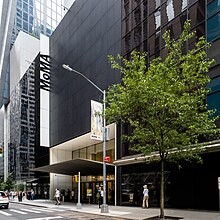 The museum's main entranceEarly years (1929–1939)
The museum's main entranceEarly years (1929–1939)
The idea for the Museum of Modern Art was developed in 1929 primarily by Abby Aldrich Rockefeller, wife of John D. Rockefeller Jr., and two of her friends, Lillie P. Bliss and Mary Quinn Sullivan.[1] They became known variously as "the Ladies" or "the adamantine ladies".[2][3] They rented modest quarters for the new museum in the Heckscher Building at 730 Fifth Avenue in Manhattan,[2] and it opened to the public on November 7, 1929, nine days after the Wall Street Crash.[4]
Abby Rockefeller had invited A. Conger Goodyear, the former president of the board of trustees of the Albright Art Gallery in Buffalo, New York, to become president of the new museum. Abby became treasurer. At the time, it was America's premier museum devoted exclusively to modern art, and the first of its kind in Manhattan to exhibit European modernism.[5] One of Rockefeller's early recruits for the museum staff was the noted Japanese-American photographer Soichi Sunami (at that time best known for his portraits of modern dance pioneer Martha Graham), who served the museum as its official documentary photographer from 1930 until 1968.[6][7]
Goodyear enlisted Paul J. Sachs and Frank Crowninshield to join him as founding trustees. Sachs, the associate director and curator of prints and drawings at the Fogg Museum at Harvard University, was referred to in those days as a "collector of curators". Goodyear asked him to recommend a director, and Sachs suggested Alfred H. Barr Jr., a promising young protégé. Under Barr's guidance, the museum's holdings quickly expanded from an initial gift of eight prints and one drawing. Its first successful loan exhibition was in November 1929, displaying paintings by Van Gogh, Gauguin, Cézanne, and Seurat.[8]
First housed in six rooms of galleries and offices on the 12th floor of Manhattan's Heckscher Building,[9] on the corner of Fifth Avenue and 57th Street, the museum moved into three more temporary locations within the next 10 years. Abby Rockefeller's husband, John D. Rockefeller Jr., was adamantly opposed to the museum (as well as to modern art itself) and refused to release funds for the venture, which had to be obtained from other sources and resulted in the frequent shifts of location. Nevertheless, he eventually donated the land for the current site of the museum, plus other gifts over time, and thus became in effect one of its greatest benefactors.[10]
During that time, the museum initiated many more exhibitions of noted artists, such as the lone Vincent van Gogh exhibition on November 4, 1935. Containing an unprecedented 66 oils and 50 drawings from the Netherlands, as well as poignant excerpts from the artist's letters, it was a major public success due to Barr's arrangement of the exhibit, and became "a precursor to the hold van Gogh has to this day on the contemporary imagination".[11]
1930s to 1950sThe museum also gained international prominence with the hugely successful and now famous Picasso retrospective of 1939–40, held in conjunction with the Art Institute of Chicago. In its range of presented works, it represented a significant reinterpretation of Picasso for future art scholars and historians. This was wholly masterminded by Barr, a Picasso enthusiast, and the exhibition lionized Picasso as the greatest artist of the time, setting the model for all the museum's retrospectives that were to follow.[12] Boy Leading a Horse was briefly contested over ownership by the Solomon R. Guggenheim Museum.[13] In 1941, MoMA hosted the ground-breaking exhibition, "Indian Art of the United States", curated by Frederic Huntington Douglas and Rene d'Harnoncourt, that changed the way Native American arts were viewed by the public and exhibited in art museums.
Abby Rockefeller's son Nelson was selected by the board of trustees to become its president, in 1939, at the age of 30; he was a flamboyant leader and became the prime instigator and funding source of MoMA's publicity, acquisitions, and subsequent expansion into new headquarters on 53rd Street. His brother, David Rockefeller, joined the museum's board of trustees in 1948, and took over the presidency when Nelson was elected governor of New York in 1958.
David Rockefeller subsequently employed noted architect Philip Johnson to redesign the museum garden, and named it in honor of his mother, the Abby Aldrich Rockefeller Sculpture Garden. The Rockefeller family and he have retained a close association with the museum throughout its history, with the Rockefeller Brothers Fund funding the institution since 1947. Both David Rockefeller Jr. and Sharon Percy Rockefeller (wife of former senator Jay Rockefeller) sit on the board of trustees.[citation needed] After the Rockefeller Guest House at 242 East 52nd Street was completed in 1950, some MoMA functions were held in the house until 1964.[14][15]
In 1937, MoMA had shifted to offices and basement galleries in the Time-Life Building in Rockefeller Center. Its permanent and current home, now renovated, designed in the International Style by the modernist architects Philip L. Goodwin and Edward Durell Stone, opened to the public on May 10, 1939, attended by an illustrious company of 6,000 people, and with an opening address via radio from the White House by President Franklin D. Roosevelt.[16]
In 1958, workers re-clad the MoMA building's second floor with a glass facade overlooking the sculpture garden.[17]
1958 fireOn April 15, 1958, a fire on the second floor destroyed an 18-foot-long (5.5 m) Monet Water Lilies painting (the current Monet Water Lilies was acquired shortly after the fire as a replacement). The fire was started by workmen installing air conditioning, who were smoking near paint cans, sawdust, and a canvas drop cloth. One worker was killed by the fire, and several firefighters were treated for smoke inhalation.
Most of the paintings on the floor had previously been removed from the work area, although large paintings including the Monet had remained in place. Art works on the third and fourth floors were evacuated to the Whitney Museum of American Art, which abutted on the 54th Street side. Among the paintings that were rescued was A Sunday Afternoon on the Island of La Grande Jatte, which had been on loan from the Art Institute of Chicago. Visitors and employees trapped above the fire were evacuated to the roof, and then jumped to the roof of an adjoining townhouse.[18]
1960s to 1980s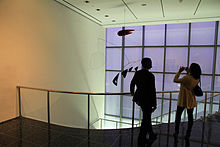 Stairs in the Museum of Modern Art
Stairs in the Museum of Modern ArtIn 1969, the MoMA was at the center of a controversy over its decision to withdraw funding from the iconic antiwar poster And Babies. In 1969, the Art Workers Coalition, a group of New York City artists who opposed the Vietnam War, in collaboration with Museum of Modern Art members Arthur Drexler and Elizabeth Shaw, created an iconic protest poster called And babies.[19] The poster uses an image by photojournalist Ronald L. Haeberle and references the My Lai Massacre. The MoMA had promised to fund and circulate the poster, but after seeing the 2-by-3-foot (0.61 m × 0.91 m) poster, MoMA pulled financing for the project at the last minute.[20][21] MoMA's board of trustees included Nelson Rockefeller and William S. Paley (head of CBS), who reportedly "hit the ceiling" on seeing the proofs of the poster.[20] The poster was included shortly thereafter in MoMA's Information exhibition of July 2 to September 20, 1970, curated by Kynaston McShine.[22]
In 1971, after protests outside the museum meant to spur inclusion of African Americans Richard Hunt was the first African American sculptor to have a major solo retrospective at the museum.[23]
In 1983, the museum more than doubled its gallery space, increased the curatorial department by 30%, and added an auditorium, two restaurants, and a bookstore in conjunction with the construction of the 56-story Museum Tower adjoining the museum.[24] Despite these expansion projects, MoMA's physical space had never been able to accommodate its growing collection.[25]: 205
On June 14, 1984 the Women Artists Visibility Event (W.A.V.E.), a demonstration of 400 women artists, was held in front of the newly renovated Museum of Modern Art to protest the lack of female representation in its opening exhibition, "An International Survey of Recent Painting and Sculpture". The exhibition featured 165 artists; only 14 of those were women.[26][27]
1990s and 2000s renovation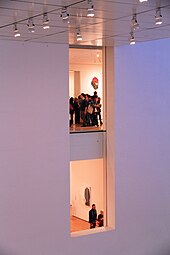 Cross-section of the Museum of Modern Art
Cross-section of the Museum of Modern ArtBy the end of the 20th century, MoMA had 100,000 objects in its collection, an increase from the 40,000 items it had in 1970. After the Dorset Hotel adjacent to the museum was placed for sale in 1996, MoMA quickly purchased it.[28] The next year, the museum began planning a major renovation and expansion,[25]: 205 selecting Japanese architect Yoshio Taniguchi in December 1997.[29][30] The project nearly doubled the space for MoMA's exhibitions and programs, and features 630,000 square feet (59,000 m2) of space.[25]: 205 Taniguchi's initial plan called for two structures, one each to the west and east of the Abby Aldrich Rockefeller Sculpture Garden, which was to be enlarged from its original configuration.[25]: 205–206 The Peggy and David Rockefeller Building on the western portion of the site houses the main exhibition gallerie, while the Lewis B. and Dorothy Cullman Education and Research Building provides space for classrooms, auditoriums, teacher-training workshops, and the museum's expanded library and archives.[25]: 207
MoMA began the year 2000 with the activation of a 1999 agreement formalizing its affiliation with the P.S. 1 Contemporary Art Center, an independent contemporary art organization which had been founded in nearby Long Island City, Queens, New York in 1971. An agreement provided for a 10-year merger process, allowing gradual coordination and consolidation of programming and staff. The location in Queens, a re-purposed former public school, would remain open to the public indefinitely, as an experimental exhibition and performance space. In addition, the PS1 space would be available while the 53rd Street complex was closed for major renovations.[31]
MoMA broke ground on the 53rd Street project in May 2001.[32] Over the next year, the museum gradually closed two-thirds of its galleries[28] and moved some of its exhibits online.[33] The Midtown building closed completely in May 2002; the next month, MoMA relocated its public-facing operations to a temporary facility called MoMA QNS in Long Island City, Queens.[34][35]
The overall project, including an increase in MoMA's endowment to cover operating expenses, cost $858 million in total;[36][37] the renovation of the Midtown Manhattan building alone cost $425 million.[38][39] During the project, new gallery space was added on the first floor of the adjacent Museum Tower, and mechanical spaces and equipment within the tower were added or relocated.[40] MoMA reopened on November 20, 2004.[41][42]
The renovation received mixed reception. John Updike wrote in The New Yorker that the new structure "has the enchantment of a bank after hours, of a honeycomb emptied of honey and flooded with a soft glow",[43] while Roberta Smith of The New York Times said MoMA had an "overly refined building, whose poor layout shortchanges the world's greatest collection of Modern art".[44] Witold Rybczynski of Slate wrote: "Most of what has been written about the new MoMA has lauded its minimalist interiors, which, even if they don't exactly disappear, have an opulently ethereal quality. [...] Yet this urban building is not experienced only from inside—and, seen from the sidewalk, Taniguchi's architecture does anything but fade away."[45]
MoMA, which owned a 17,000 sq ft (1,600 m2) lot at 53 West 53rd Street west of its existing building, sold it to developer Gerald D. Hines for $125 million in January 2007.[46][47] Hines planned to build a skyscraper called Tower Verre on the site.[48] Work on the tower was delayed because of a lack of funding following the financial crisis of 2007–2008.[49][50]
2010s to present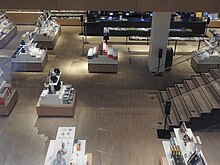 The museum's basement gift shop
The museum's basement gift shopIn 2010, MoMA completed its merger with the P.S. 1 Contemporary Art Center in Long Island City, New York, formally renaming it as MoMA PS1.[51]
In 2011, MoMA acquired an adjacent building that housed the American Folk Art Museum on West 53rd Street. The building had been completed in 2001 to designs by Tod Williams Billie Tsien Architects and was sold in connection with a financial restructuring of the Folk Art Museum.[52] In January 2014, MoMA decided to raze the American Folk Art Museum, which was between MoMA's existing structure and the proposed tower at 53 West 53rd Street.[53][54] The architectural community protested the planned demolition in part because that building was relatively new, having been completed in 2001.[55] MoMA decided to proceed with the demolition because the American Folk Art Museum was in the way of MoMA's planned expansion, which included exhibition space within 53 West 53rd Street.[56][57] The tower, designed by Jean Nouvel and called 53W53, received construction approval in 2014.[58]
Around the same time as 53W53 was approved, MoMA unveiled its expansion plans, which encompass space in 53W53, as well as an annex on the former site of the American Folk Art Museum.[54] The expansion plan was developed by the architecture firm Diller Scofidio + Renfro in collaboration with Gensler. Following a controversy over the plans, MoMA split the plan into three phases in January 2016. The plan would add 50,000 square feet (4,600 m2) of gallery space in 53W53, in a new annex designed by Diller Scofidio + Renfro, and in the existing building, as well as expanded lobbies.[59][60] In June 2017, the first phase of the $450 million expansion was completed.[61][62]
Spread over three floors of the art mecca off Fifth Avenue are 15,000 square-feet (about 1,400 m2) of reconfigured galleries, a new, second gift shop, a redesigned cafe and espresso bar, and facing the sculpture garden, two lounges graced with black marble quarried in France.[61]
The museum expansion project increased the publicly accessible space by 25% compared to when the Tanaguchi building was completed in 2004.[63] The expansion allowed for even more of the museum's collection of nearly 200,000 works to be displayed.[61] The new spaces also allow visitors to enjoy a relaxing sit-down in one of the two new lounges, or even have a fully catered meal.[61] The two new lounges include "The Marlene Hess and James D. Zirin Lounge" and "The Daniel and Jane Och Lounge".[61][64] The goal of this renovation is to help expand the collection and display of work by women, Latinos, Blacks, Asians, and other marginalized communities.[65] In connection with the renovation, MoMA shifted its approach to presenting its holdings, moving away from separating the collection by disciplines such as painting, design, and works on paper toward an integrated chronological presentation that encompasses all areas of the collection.[63]
The Museum of Modern Art closed for another round of major renovations from June to October 2019.[65][66] Upon reopening on October 21, 2019, MoMA added 47,000 square feet (4,400 m2) of gallery space, bringing its total floor area to 708,000 square feet (65,800 m2).[67][68]







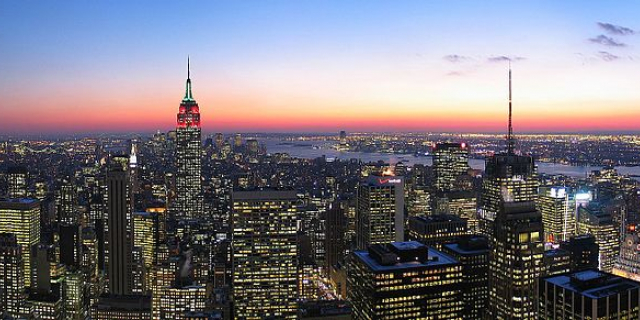




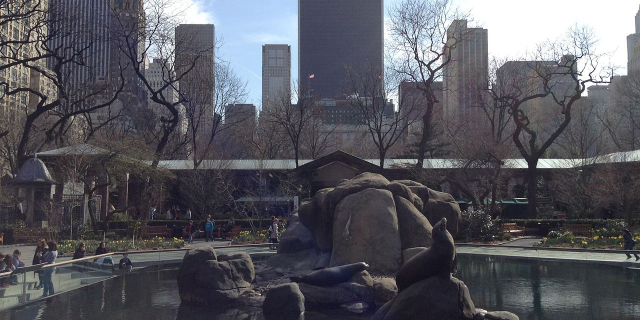

















Add new comment